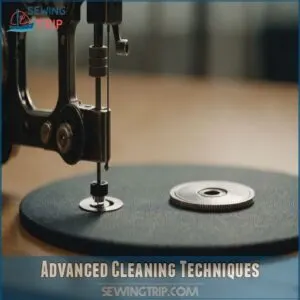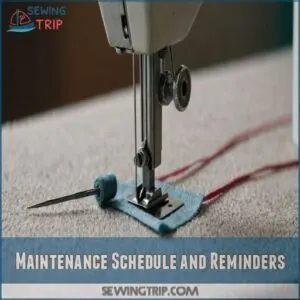This site is supported by our readers. We may earn a commission, at no cost to you, if you purchase through links.

Use soft brushes to whisk away lint and threads from delicate parts, and try compressed air for those pesky corners you can’t reach.
A microfiber cloth is perfect for a shiny exterior, while monthly oiling prevents squeaky surprises.
Remember, a covered machine is a happy machine, protected from dust gremlins!
Regular cleaning doesn’t just maintain perfect stitches; it also dodges unexpected breakdowns.
So, what’s the next step in ensuring your trusty machine stays in tip-top shape?
Table Of Contents
- Key Takeaways
- Importance of Cleaning Sewing Machines
- Cleaning Tools and Techniques
- Preparing The Workspace
- Cleaning The Sewing Machine
- Oiling and Lubricating The Machine
- Deep Cleaning The Sewing Machine
- Troubleshooting Common Issues
- Protecting Your Investment
- Advanced Cleaning Techniques
- Maintenance Schedule and Reminders
- Frequently Asked Questions (FAQs)
- Conclusion
Key Takeaways
- Regular cleaning and oiling every 8-10 hours of use prevents breakdowns and maintains perfect stitches.
- To maintain your sewing machine’s performance, remember daily users should clean and oil their sewing machines weekly, especially for heavy fabrics. Use soft brushes and compressed air to remove lint from delicate and hard-to-reach parts, keeping the machine running smoothly.
- Store your machine in a dust-free environment and cover it when not in use to protect it from dust buildup.
- Schedule annual professional servicing for deep cleaning and lubrication to extend your machine’s lifespan.
Importance of Cleaning Sewing Machines
You might be surprised how much joy a clean sewing machine can bring—it keeps your stitches perfect and saves you from unexpected breakdowns.
Regular cleaning prevents that dreadful needle damage and helps your beloved machine run smoother than a cat on a sunny windowsill.
Preventing Wear and Tear
Preventing wear and tear on your sewing machine is like giving it a little spa day.
Regular cleaning and sewing machine care make sure that proper needle usage, lubrication benefits, and thread tension stay spot-on.
By following simple sewing machine cleaning hacks, you can keep your machine running smoothly and extend its lifespan.
Keep your beloved machine dust-free with sewing machine covers, and stick to the recommended cleaning frequency.
A little maintenance
Reducing Risk of Breakdowns
Imagine this: your trusty sewing machine, refusing to stitch mid-project. You can avoid such headaches with regular upkeep.
Here’s how to lower breakdown risks:
- Preventive Maintenance: Establish a regular cleaning schedule.
- Oiling Schedule: Lubricate monthly to keep parts moving smoothly.
- Proper Storage: Store in a dust-free area to avoid debris build-up.
Happy sewing!
Maintaining Perfect Stitches
A clean machine means consistent stitches.
Using tools like a seam ripper for mistakes can also help, but think of it like this: a clogged needle is like a grumpy artist—it won’t produce its best work.
Regular sewing machine cleaning, including proper lint removal techniques, and proper bobbin winding and needle selection, keeps thread tension even.
This leads to beautiful stitch quality and boosts your sewing machine.
Cleaning Tools and Techniques
To keep your sewing machine purring like a contented cat, you’ll want to arm yourself with the right cleaning tools and techniques.
Think of soft brushes, compressed air, and microfiber cloths as your secret weapons in preventing a dust-bunny invasion!
Soft Brushes for Delicate Parts
You’ve been stitching up a storm, and now it’s time for a little TLC.
Soft brushes are a gentle wonder for delicate sewing machine parts, gliding through nooks with ease.
Regular brushing, including monthly oiling maintenance, will keep your machine running smoothly and help you say goodbye to stubborn lint and keep every stitch flawless.
These brushes are real multitaskers, making your sewing machine feel as fresh as a new
Compressed Air for Hard-to-Reach Areas
Soft brushes work wonders, yet some dust will still play hide and seek.
That’s where compressed air comes in.
To keep your sewing machine running smoothly, it’s essential to clean the bobbin case regularly, ideally every 1-3 months or after 10-15 projects, by following steps outlined in how to clean bobbin case. Give hard-to-reach spots like the sewing machine motor or bobbin case a blast, clearing away stubborn debris.
Aim carefully—too much pressure can spell trouble.
Follow dust removal tips to make sure safety, keeping your sewing machine purring smoothly and reliably.
Microfiber Cloths for Exterior Cleaning
After blasting away lint with compressed air, grab a microfiber cloth to tackle the exterior grime.
These cloths come in a variety of types, perfect for every surface.
They’re like a gentle giant, wiping away dust without scratching.
Keep them clean and dry for best results—a dirty cloth just spreads the dirt, and nobody wants that!
Needle Removers for Safe Needle Replacement
Let’s talk needle removers—they’re your best friends when dealing with sewing machine needles.
With the right tool, you avoid awkward slips and guarantee needle safety.
Consider these benefits:
- Peace of mind from needle damage
- Precision in handling different needle types
- Ease in maintaining needle size consistency
- Enhanced sewing machine maintenance
- Improved sewing machine cleaning
Isn’t that a relief?
Preparing The Workspace
Before you roll up your sleeves and start scrubbing, make sure your workspace is clean and organized to avoid spreading lint all over.
A tidy area protects your sewing machine from dust and dirt, but it also makes the cleaning process more enjoyable, kind of like preparing for a craft party.
Removing Lint and Debris
Now that you’ve gathered your tools, let’s tackle those pesky lint bunnies!
Before you start, clear your workspace.
A clean area means a clean machine!
Here’s a quick guide:
| Task | Tool |
|---|---|
| Remove bobbin case lint | Small brush, compressed air |
| Clean under feed dogs | Lint brush, compressed air |
| Remove lint from crevices | Lint removal tools |
| General lint removal | Lint brush |
Remember, a little prevention goes a long way!
Regular cleaning keeps your sewing machine purring like a kitten.
Cleaning The Exterior of The Machine
An exterior cleaning keeps your sewing machine looking fresh and running like a charm.
Wipe surface smudges with a microfiber cloth, remove dust using soft brushes, and tackle stubborn oil spots with a gentle cleaner.
Reach those tricky spots with compressed air.
Keep these trusty cleaning tools handy—your machine will thank you!
- Microfiber cloths
- Soft brushes
- Compressed air
- Gentle cleaner
- Regular maintenance
Protecting The Workspace From Dust and Dirt
Cleaning the sewing machine’s exterior sets the stage.
You might feel like you’re chasing ghosts, but it’s worth it!
A well-organized sewing space is key, and a great sewing room organizer can help you keep things tidy.
Protect your workspace from dust with these tips:
| Concern | Solution |
|---|---|
| Dust accumulation | Use air filtration |
| Clutter | Optimize organization |
| Storage | Invest in clean space |
Your machine deserves some tender loving care, keeping it happy and hummy.
Cleaning The Sewing Machine
Keeping your sewing machine clean is like giving your car a tune-up; it keeps things running smoothly and avoids costly repairs.
Lint and cleaning the bobbin area every few uses will keep your machine running smoothly.
Spend a little time removing lint and cleaning the bobbin area every few uses, and your machine will purr like a kitten instead of roaring like a dinosaur.
General Cleaning After 8-10 Hours of Use
After clearing your workspace, it’s time to give your hardworking sewing machine a little TLC every 8-10 hours of use.
Before you start cleaning, remember to unplug the machine first to prevent any electrical risks.
Start by removing the thread, then replace the needle with every cleaning—think of it as swapping tires for better traction.
Oil the moving parts with sewing machine oil sparingly, ensuring everything runs like
Removing Lint and Fuzz From The Machine
You’ve just finished the general cleaning, and now it’s time to tackle lint and fuzz.
Grab your trusty sewing machine brushes and gently sweep those pesky bits away.
A lint brush technique works wonders for hidden lint traps.
Don’t let lint buildup become your nemesis; keep those fuzzy invaders out to save your stitches and sanity!
Cleaning The Bobbin Area and Feed Dogs
Think about giving your sewing machine some DIY love by tackling the bobbin area and feed dogs—it’s a real game-changer.
First, remove the needle plate.
Second, gently brush away lint.
Third, wipe the bobbin case clean.
Fourth, add a smidge of oil to the feed dogs.
These sewing machine cleaning tips will keep your stitches neat, preventing jams.
Oiling and Lubricating The Machine
Regular oiling keeps your sewing machine happy and humming along; a little lubrication goes a long way in preventing squeaks, groans, and those frustrating breakdowns.
Monthly Oiling of Moving Parts
Now that your machine’s exterior sparkles, let’s chat about oil.
A monthly oiling keeps gears turning like a well-rehearsed dance.
Use high-quality sewing machine oil to lubricate moving parts.
With just a few drops on the needle bar and presser foot, you’ll prevent squeaks and wear, ensuring every stitch is smooth and flawless.
Happiness is a well-oiled machine!
Annual Servicing for Deep Cleaning and Lubrication
Imagine: you’re sipping coffee, sewing away happily, when suddenly—screech!
Enter annual servicing, the knight in shining armor of sewing maintenance.
Regular professional services make sure deep cleaning and proper lubrication happen, sparing you surprise breakdowns.
They access those stubborn, hard-to-reach areas with finesse.
With a maintenance schedule, your beloved machine can sing like new, year after year.
Don’t skip it; it’s golden!
Deep Cleaning The Sewing Machine
When it’s time for a deep clean, think of it like giving your trusty sewing machine the spa day it deserves.
You’ll be tackling those hard-to-reach spots and ensuring everything’s in excellent shape, so grab your toolkit and get ready to make it purr again!
Professional Servicing for Hard-to-Reach Areas
After you’ve oiled every nook and cranny, consider a professional service for those elusive hard-to-reach areas.
It’s like having your sewing machine enjoy a spa day—refreshing and essential.
The benefits? It keeps everything running smoothly and saves you future headaches.
Find a trusted technician, and schedule regular check-ups.
Trust me, your stitches will thank you!
Adjusting Tensions and Timing
You’ve nailed the professional servicing; to prevent skipped stitches, remember to clean your machine after every 8-10 hours of use like prepping the machine; let’s tackle adjusting tensions and timing to boost your sewing machine’s stitch quality.
Tension adjustments are like tuning an instrument—balance between top and bobbin tension ensures smooth harmony.
By regularly checking and fine-tuning your sewing machine thread tension, you can prevent issues like uneven stitches, thread breakage, and fabric puckering.
Got timing issues? Needle and hook should
Replacing Worn Parts and Cleaning The Shuttle
Every now and then, give your sewing machine a little TLC by replacing worn parts and cleaning the shuttle.
Spotting worn part signs early keeps your DIY repair game strong.
Regularly oiling the shuttle and other moving metal components, as outlined in the sewing machine care guide, is essential for maintaining your machine’s performance. For shewing machine cleaning tips isn’t the proper term and should be "sewing machine cleaning tips" or use shewing, use a drop or two of sewing machine oil to keep it happy.
Regular servicing frequency and seamless sewing are more BFF material than you’d think!
Troubleshooting Common Issues
So, your sewing machine’s acting up? Let’s troubleshoot those common problems and get you stitching again in no time!
We’ll cover identifying wear and tear, fixing bobbin and feed dog issues, and even when to replace parts – because a happy machine makes happy projects.
Identifying Signs of Wear and Tear
Spotting wear and tear can save you a world of trouble down the road.
Listen for any sudden noisy operation or notice skipped stitches—it’s your machine’s way of calling for help.
Check for loose parts or needle breakage; these aren’t just quirks, they’re cries for a little sewing machine troubleshooting or repair to keep everything humming smoothly.
Resolving Issues With The Bobbin and Feed Dogs
Bobbin tension problems or a jammed bobbin case got you pulling your hair out? Fear not—keeping your machine humming like a well-oiled singer means checking that bobbin’s snug fit.
Use a brush for bobbin case cleaning and make sure feed dog alignment to avoid skipping.
Regular feed dogs cleaning with sewing machine cleaning tools boosts sewing machine performance and prolongs its life.
Repairing or Replacing Damaged Parts
Got a sewing machine that’s acting up? Maybe it’s time for some DIY magic or even a trip to the pros:
- Identify broken parts with a keen eye to prevent surprises.
- Sourcing replacements might be your next adventure.
- Weigh DIY repair against professional help to save cash.
Remember, a little love and lubrication go a long way!
Protecting Your Investment
You’ve invested in a trusty sewing machine, so make sure it’s safe and sound by storing it in a clean environment and keeping it dust-free.
Think of regular maintenance as giving your machine a spa day—it’s a simple way to guarantee top performance while saving you from any sewing mishaps!
Storing The Machine in a Clean Environment
Solving sewing machine hiccups can feel like herding cats.
Once handled, think about where you store the machine.
A dust-free storage spot can work wonders for keeping your investment safe.
Pick a clean workspace that’s quiet and clutter-free to protect it.
Let’s keep that needle humming happily without unexpected surprises.
| Storage Tip | Benefit | Action |
|---|---|---|
| Dust-free storage | Prevents dust buildup | Use a clean environment |
| Clean workspace | Keeps machine spotless | Designate a tidy area |
| Ideal environment | Reduces wear and tear | Choose a calm location |
Keeping The Machine Covered and Dust-Free
Preservation’s key? Keep your sewing machine dust-free! Invest in a good dust cover; it’s your machine’s best friend. Think of it as a superhero cape against dust bunnies.
Regularly wipe it down with a microfiber cloth for a sparkling clean.
Proper storage is vital for machine longevity, extending its lifespan. A clean workspace keeps things running smoothly. This simple act protects your investment and keeps your sewing projects enjoyable!
Regular Maintenance for Optimal Performance
To keep your sewing machine ticking like a loyal friend, incorporate regular maintenance into your routine.
A reliable sewing machine maintenance schedule and a solid lubrication routine with proper sewing machine oil, such as those found at a sewing machine oil supplier, work wonders for sewing machine longevity.
It’s like brushing your teeth—do it and enjoy a smooth run.
So grab those cleaning
Advanced Cleaning Techniques
You’re ready to tackle some advanced sewing machine maintenance and cleaning tasks, like using a fine-grade oil for lubrication learn more about oiling your machine. You’re ready to tackle some advanced cleaning techniques that’ll keep your sewing machine running smoother than grandma’s buttered biscuits.
Grab your tools, because cleaning tension discs, the motor, and even the foot pedal will be a breeze with these practical tips!
Cleaning The Tension Discs and Shuttle
Your sewing machine’s tension discs and shuttle deserve a little TLC to keep things from going haywire. Gently run fleece with rubbing alcohol through the tension discs to remove gunk. Refresh the shuttle’s shine with a bit of oil and steel wool.
Here’s your checklist:
- Tension disc cleaning
- Shuttle lubrication
- Removing oil residue
- Preventing damage
Cleaning The Motor and Foot Pedal
Tackling the motor and foot pedal might seem intimidating, but it’s surprisingly manageable!
Grab your motor cleaning tools and remove dust with a soft brush or toothbrush.
Check for wear and apply sewing machine oil for smooth operation.
Open the foot pedal with care, dust away dirt, and add a drop of lubricant to the moving parts—job done!
Using Compressed Air and Cleaning Fluids Safely
Ever wondered if your sewing machine’s health hinges on proper cleaning techniques?
Let’s chat about it.
Using compressed air safely means not overdoing it—just a quick puff is enough.
Make sure fluid compatibility to avoid machine damage.
Here are some tips:
- Check labels for cleaning supplies.
- Use gentle blows with compressed air.
- Avoid harsh chemicals.
- Follow the manual instructions.
Maintenance Schedule and Reminders
Keeping your sewing machine in tip-top shape is as easy as sticking to a regular cleaning schedule and jotting down quick reminders.
Think of it like taking your car for regular oil changes—your future self will thank you for staying organized and on track!
Creating a Cleaning Schedule
So, you’ve mastered deep cleaning? Fantastic! Now, let’s create a sewing machine maintenance schedule. Think of it like a car’s service plan—preventative care is key.
Set reminders for monthly oiling and yearly servicing. Use a simple calendar or app; whatever works for you. This simple timeline will keep your machine singing!
Regular cleaning, using the right tools, will become second nature.
Tracking Maintenance and Servicing History
Keeping a detailed sewing machine log is like having a personal diary for your trusty machine.
Jot down every service visit, maintenance move, and repair tale.
This repair history helps you catch problems before they turn catastrophic, ensuring a longer life.
To determine the best schedule for your log, consider how often to service your sewing machine, such as servicing heavy use.
Set a **maintenance
Staying Organized for Optimal Machine Performance
Imagine smoothly sailing through your sewing projects with organization as your co-captain.
Keep your sewing machine running like a charm by staying organized with these tips:
- Maintenance log to track cleanings and services.
- Storage solutions for all those tiny notions.
- Cleaning supplies within easy reach.
- Needle organization to prevent mix-ups.
- Workspace setup for efficient sewing and cleaning.
Frequently Asked Questions (FAQs)
How to clean a sewing machine like a pro?
Start by unplugging your sewing machine, then use a soft brush to dust out lint.
Carefully remove and clean the bobbin area, apply sewing oil where needed, and wipe everything down.
Voilà, you’re a pro at machine maintenance!
How do you clean a sewing machine?
Your sewing machine’s like a car; it needs regular upkeep.
Unplug it, dust the bobbin with a brush, vacuum lint, and oil moving parts monthly.
Use the proper tools—compressed air and soft brushes work wonders.
Keep it running smooth!
How often should you clean your sewing machine?
Clean your sewing machine after every 8-10 hours of use!
A quick brush-down after each project helps too.
Monthly oiling keeps things running smoothly.
Yearly professional servicing is a must for deep cleaning.
How to maintain a sewing machine?
Imagine sewing a quilt and then your machine stalls—yikes!
To maintain your sewing machine, oil it monthly, clean lint regularly, and get annual checks.
Your machine will purr like a kitten and sew like a dream!
How do you clean a sewing machine with LINT?
Tired of fuzzy disasters in your sewing machine?
Grab a small brush to sweep away lint, focusing under the needle plate and around the bobbin case.
Use compressed air for those hard-to-reach spots, keeping things pristine.
Does a sewing machine clean itself?
Sewing machines don’t magically spruce themselves up.
Just like your favorite car needs regular checks, your sewing buddy needs a hand.
A bit of TLC now and then keeps it humming sweet tunes and stitching seamlessly.
How Often Should I Change the Needle on My Sewing Machine?
Swap your sewing machine needle after every 8 to 10 hours of sewing.
Trust me, your stitches stay sharp, and you dodge fabric snags.
Plus, it’s like getting new tires for your sewing adventures!
What Kind of Brushes or Cleaning Tools Work Best for Cleaning a Sewing Machine?
You’ll want soft brushes for gently removing lint from your sewing machine.
Consider using compressed air for tight spaces and a microfiber cloth for the exterior.
Trust me, your machine will thank you for it!
How Do I Know When My Sewing Machine Needs a Professional Servicing?
When your sewing machine sings a sad song—like skipping stitches, jamming, or sounding noisier than a toddler’s tantrum—it’s time for professional servicing.
Periodic annual checkups keep your creative companion running smoothly and efficiently.
What Are Signs That My Sewing Machine Needs Repairs or Worn Part Replacements?
Notice skipped stitches?
Is your machine making weird noises?
Or are your threads constantly breaking?
These are all signs it needs some TLC—maybe even a new part!
Don’t delay; get it checked.
Is It Safe to Use Compressed Air to Blow Lint Out of My Sewing Machine?
Sure, diving into the depths of your sewing machine can be tricky.
Using compressed air is generally safe, but use it sparingly and carefully, as it can push lint deeper, making future cleaning a real hassle.
What is the best way to clean a sewing machine?
Start with removing the needle and bobbin, then brush away lint.
Use compressed air for tight spots and a microfiber cloth for exteriors.
Oil moving parts monthly and seek professional service yearly.
It’s like a spa day!
What are the 7 steps in cleaning the sewing machine?
Cleaning a sewing machine involves unplugging it, removing needles and bobbins, brushing away lint, using compressed air, cleaning the bobbin area, oiling moving parts, and finally wiping it down.
It’s like giving your machine a spa day!
What can I use to clean the outside of my sewing machine?
Give your sewing machine’s exterior some TLC with a microfiber cloth and a little bit of mild soap mixed with water.
Gently wipe away dust and grime.
Avoid harsh chemicals that could damage the finish.
How often should you clean a sewing machine?
You should clean your sewing machine every 8 to 10 hours of use to keep it humming smoothly.
Regular cleaning prevents breakdowns.
Regular cleaning keeps stitches perfect.
Regular cleaning extends the life of your trusty sewing companion!
What should I avoid using on my sewing machine?
Imagine your sewing machine as a finicky cat—don’t use WD-40, abrasive scrubbers, or household cleaners on it.
Stick to sewing machine oil and gentle tools that won’t scratch its delicate parts.
Keep it purring smoothly!
How do I safely store sewing machine accessories?
Keep your needles and bobbins in a labeled container, preferably airtight.
Store presser feet and other small parts in a clear, organized case to prevent loss or damage.
That way, you’ll always know where everything is!
Can I use alternative lubrication for sewing machines?
Daredevil spirit running wild with oil choices?
Stick with sewing machine oil!
Avoid substitutes like WD-40 or cooking oils, which can gum up the works.
Your machine hums best with the good stuff; treat it right!
Are there specific conditions to avoid for machine storage?
Store your sewing machine in a dry, dust-free environment away from extreme temperatures.
Avoid basements and attics, as moisture and dirt love to lurk there.
Your machine deserves a cozy corner, safe from sunlight and vibrations.
What should I check for before using the machine after cleaning?
Did you know regular cleaning boosts sewing efficiency by 30%?
Before sewing, check for a lint-free bobbin, smooth needle movement, correct threading, and no stray threads.
Make sure the machine’s oiled, properly tensioned, and all parts reassembled.
Conclusion
Treat your sewing machine like a best friend—it’ll sew through anything perfectly if you keep it clean.
With these sewing machine cleaning tips, you’ll dodge breakdowns and keep those stitches neat.
Grab soft brushes for delicate spots, use a microfiber cloth to shine it up, and don’t skip the monthly oiling.
A little maintenance goes a long way in protecting your investment.
Keep your machine happy and it’ll keep helping you create magic!



















